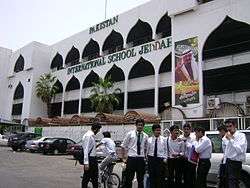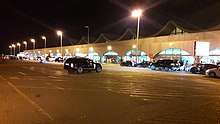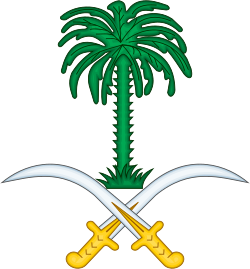Jeddah
Jeddah (English: /ˈdʒɛdə/ JED-ə), also spelled Jedda, Jiddah or Jidda (/ˈdʒɪdə/ JID-ə; Arabic: جدة, romanized: Jidda, Hejazi pronunciation: [ˈdʒɪd.da]), is a city in the Hejaz region of Saudi Arabia and the country's commercial center. With a population of about four million people (as of 2017), Jeddah is the largest city in Makkah Province,[3] the second-largest in Saudi Arabia (after the capital Riyadh), and the tenth-largest in the Arab world.[4] Jeddah Islamic Port, located on the Red Sea, is the second-largest and second-busiest seaport in the Arab world (after Dubai's Port of Jebel Ali).
Jeddah جدة Jedda Jiddah Jidda | |
|---|---|
City | |
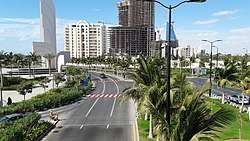 Image of the city center in 2019 | |
| Nickname(s): The Mermaid | |
| Motto(s): Jeddah Is Different | |
 Location of Jeddah within Saudi Arabia | |
| Coordinates: 21°32′36″N 39°10′22″E | |
| Country | |
| Region | Makkah (Mecca) |
| Established | From the 6th century BC |
| Government | |
| • City Mayor | Saleh Al-Turki[1] |
| • City Governor | Mish'al Al-Saud |
| • Provincial Governor | Khaled Al-Faisal |
| Area | |
| • City | 1,600 km2 (600 sq mi) |
| • Urban | 1,686 km2 (651 sq mi) |
| • Metro | 47 km2 (18 sq mi) |
| Elevation | 12 m (39 ft) |
| Population (2014)[2] | |
| • City | 3,976,000 |
| • Density | 2,500/km2 (6,400/sq mi) |
| Time zone | UTC+3 (AST) |
| • Summer (DST) | AST |
| Postal Code | 5 digit codes beginning with 21 (e.g. 21577) |
| Area code(s) | +966-12 |
| Website | www |
| Official name | Historic Jeddah, the Gate to Makkah |
| Criteria | Cultural: ii, iv, vi |
| Reference | 1361 |
| Inscription | 2014 (38th session) |
| Area | 17.92 ha |
| Buffer zone | 113.58 ha |
Jeddah is the principal gateway to Mecca, the holiest city in Islam, located just 65 kilometres (40 mi) to the east, while Medina, the second-holiest city, is located 360 kilometres (220 mi) to the north.
Economically, Jeddah is focusing on further developing capital investment in scientific and engineering leadership within Saudi Arabia, and the Middle East.[5] Jeddah was independently ranked fourth in the Africa – Mid-East region in terms of innovation in 2009 in the Innovation Cities Index.[6]
Jeddah is of Saudi Arabia's primary resort cities and was named a Beta world city by the Globalization and World Cities Study Group and Network (GaWC). Given the city's close proximity to the Red Sea, fishing and seafood dominates the food culture unlike other parts of the country. In Arabic, the city's motto is "Jeddah Ghair", which translates to "Jeddah is different". The motto has been widely used among both locals as well as foreign visitors. The city had been previously perceived as the "most open" city in Saudi Arabia.
Etymology and spelling
There are at least two explanations for the etymology of the name Jeddah, according to Jeddah Ibn Al-Qudaa'iy, the chief of the Quda'a clan. The more common account has it that the name is derived from جدة Jaddah, the Arabic word for "grandmother". According to eastern folk belief, the tomb of Eve, considered the grandmother of humanity, is located in Jeddah.[7] The tomb was sealed with concrete by religious authorities in 1975 due to some Muslims praying at the site.
The Berber traveler Ibn Battuta visited Jeddah during his world trip in around 1330. He wrote the name of the city into his diary as "Jiddah".[8]
The British Foreign and Commonwealth Office and other branches of the British government formerly used the older spelling of "Jedda", contrary to other English-speaking usage, but in 2007, it changed to the spelling "Jeddah".[9]
T. E. Lawrence felt that any transcription of Arabic names into English was arbitrary. In his book, Revolt in the Desert, Jeddah is spelled three different ways on the first page alone.[10]
On official Saudi maps and documents, the city name is transcribed "Jeddah", which is now the prevailing usage.
History
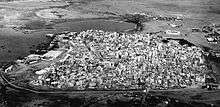
Some archaeologists' studies suggest the existence of inhabitants in the region now known as Jeddah since the Stone Age seeing as they found some artifacts and 'Thamoudian' writings in Wadi (valley) Breiman east of Jeddah and Wadi Boib northeast of Jeddah. Some historians trace its founding to the tribe of Bani Quda'ah, who inhabited it after the collapse of Sad (dam) Ma'rib in 115 BC. Some believe that Jeddah had been inhabited before the tribe of Bani Quda'ah by fishermen in the Red Sea, who considered it a center from which they sailed out into the sea as well as a place for relaxation and well-being. According to some accounts, the history of Jeddah dates back to early times before Alexander the Great, who visited the city between 323 and 356 BC.[11]
Pre-Islam
Excavations in the old city suggest that Jeddah was founded as a fishing hamlet in 522 BC by the Yemeni Quda'a tribe (بني قضاعة), who left central Yemen to settle in Makkah[12] after the destruction of the Marib Dam in Yemen.[13]
Other archaeological studies have shown that the area was settled earlier by people in the Stone Age, as some Thamudi scripts were excavated in Wadi Briman (وادي بريمان), east of the city, and Wadi Boweb (وادي بويب), northwest of the city. The city of Jeddah was an important port in the Nabataean frankincense trade. The oldest Mashrabiya found in Jeddah dates back to the pre-Islamic era.
Rashidun Caliphate
Jeddah first achieved prominence around AD 647, when the third Muslim Caliph, Uthman Ibn Affan, turned it into a port making it the port of Makkah instead of Al Shoaiba port south west of Mecca.[14] In AD 703 Jeddah was briefly occupied by pirates from the Kingdom of Axum.[15] Jeddah has been established as the main city of the historic Hijaz province and a historic port for pilgrims arriving by sea to perform their Hajj pilgrimage in Mecca.
Umayyad Caliphate
Umayyads inherited the entire Rashidun Caliphate including Hejaz and ruled from 661AD to 750AD. No historic records mention important events taking place in Jeddah during this period of history.
However, Jeddah has remained as key civilian harbor, serving fishermen and sea travelling pilgrims to Hajj. it is also believed that Sharifdom of Mecca; an honorary Viceroy to the holyland. was first appointed in this period of the Islamic Caliphate.
Abbasid Caliphate
Abbassids, the new superpower, became the new successor to the Umayyad. In 750 the Abbasid Revolution successfully took control of almost the whole Umayyad Empire, excluding Morocco (Maghrib) and Spain (Al-Andalus). The Caliphate of Baghdad kept expanding and ruled until 1258, while Hejaz only remained under the Abbasid throne until 876, when the Tulunids of Egypt gained control of the Emirate of Egypt, Syria, Jordan and Hejaz.
Tulunid Wilayah and Ikhshidid Wilayah
The power struggle between Tulunid Governors and Abbasid over Hejaz lasted for 30 years when the Tulunids finally withdrew from Arabia in 900 AD.
In 930 AD, main Hejazi cities Medina, Mecca and Taif were heavily sacked by Qarmatians. However, it is not historically confirmed that Jeddah itself was attacked by Qarmatians.
However, Ikhshidids Governors of Abbasids, the new power in Egypt took control of Hejaz in early 935. No historic records details the even during Ikhshidids rule of Hejaz.
Jeddah was still unfortified and without walls at this point of time.
Fatimid Caliphate
In the 969 AD, the Fatimids from Algeria took control in Egypt from the Ikhshidid Governors of Abbasids and expanded their empire to the surrounding regions, including The Hijaz and Jeddah. The Fatimids developed an extensive trade network in both the Mediterranean and the Indian Ocean through the Red Sea. Their trade and diplomatic ties extended all the way to China and its Song Dynasty, which eventually determined the economic course of Tihamah during the High Middle Ages.
Ayyubid Empire
After Saladin's conquest of Jerusalem, in 1171 he proclaimed himself sultan of Egypt, after dissolving the Fatimid Caliphate upon the death of al-Adid, thus establishing the Ayyubid dynasty. Ayyubid conquests in Hejaz included Jeddah, which joined the Ayyubid Empire in 1177 during the leadership of Sharif Ibn Abul-Hashim Al-Thalab (1094–1201). During their relatively short-lived tenure, the Ayyubids ushered in an era of economic prosperity in the lands they ruled and the facilities and patronage provided by the Ayyubids led to a resurgence in intellectual activity in the Islamic world. This period was also marked by an Ayyubid process of vigorously strengthening Sunni Muslim dominance in the region by constructing numerous madrasas (Islamic schools) in their major cities. Jeddah attracted Muslim sailors and merchants from Sindh, Southeast Asia and East Africa, and other distant regions.
Mamluk Sultanate
In 1254, following events in Cairo and the dissolution of the Ayyubid Empire, Hijaz became a part of the Mamluk Sultanate. The Portuguese explorer Vasco da Gama, having found his way around the Cape and obtained pilots from the coast of Zanzibar in AD 1497, pushed his way across the Indian Ocean to the shores of Malabar and Calicut, attacked fleets that carried freight and Muslim pilgrims from India to the Red Sea, and struck terror into the surrounding potentates. The Princes of Gujarat and Yemen turned for help to Egypt. Sultan Al-Ashraf Qansuh al-Ghawri accordingly fitted out a fleet of 50 vessels under his Admiral, Hussein the Kurd. Jeddah was soon fortified with a stone wall, using forced labor, as a harbor of refuge from the Portuguese, allowing Arabia and the Red Sea to be protected. Parts of the city wall still survive today in the old city. Even though the Portuguese were successfully repelled from the city, fleets in the Indian Ocean were at their mercy. This was evidenced by the Battle of Diu between the Portuguese and the Arab Mamluks. The Portuguese soldiers' cemetery can still be found within the old city today and is referred to as the site of the Christian Graves.[16]
Ottoman Empire

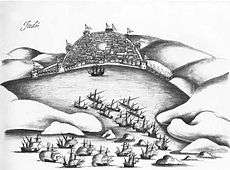
In 1517, the Ottoman Turks conquered the Mamluk Sultanate in Egypt and Syria, during the reign of Selim I.[18] As territories of the Mamluk Sultanate, the Hijaz, including Jeddah and the holy city of Mecca, passed into Ottoman possession. The Ottomans rebuilt the weak walls of Jeddah in 1525 following the defense of the city against the Lopo Soares de Albergaria's Armada arriving from the Red Sea. The new Turkish wall included six watchtowers and six city gates. They were constructed to defend against the Portuguese attack. Of the six gates, the Gate of Mecca was the eastern gate and the Gate of Al-Magharibah, facing the port, was the western gate. The Gate of Sharif faced south. The other gates were the Gate of Al-Bunt, Gate of Al-Sham (also called Gate of Al-Sharaf) and Gate of Medina, facing north.[19] The Turks also built The Qishla of Jeddah, a small castle for the city soldiers. In the 19th century these seven gates were minimized into four giant gates with four towers. These giant gates were the Gate of Sham to the north, the Gate of Mecca to the east, the Gate of Sharif to the south, and the Gate of Al-Magharibah on the sea side.
Ahmed Al-Jazzar, the Ottoman military man mainly known for his role in the Siege of Acre, spent the earlier part of his career at Jeddah. In Jeddah in 1750, he killed some seventy rioting nomads in retaliation for the killing of his commander, Abdullah Beg, earning him the nickname "Jezzar" (butcher).
On 15 June 1858, rioting in the city, believed to have been instigated by a former police chief in reaction to British policy in the Red Sea, led to the massacre of 25 Christians, including the British and French consuls, members of their families, and wealthy Greek merchants.[20] The British frigate HMS Cyclops, anchored at port, bombarded the city for two days in retaliation.[21]
First Saudi State and Ottoman–Saudi War
In 1802, Nejdi forces conquered both Mecca and Jeddah from the Ottomans. When Sharif Ghalib Efendi informed Sultan Mahmud II of this, the Sultan ordered his Egyptian viceroy Muhammad Ali Pasha to retake the city. Muhammad Ali successfully regained the city in the Battle of Jeddah in 1813.
World War I and the Hashemite Kingdom

During World War I, Sharif Hussein bin Ali declared a revolt against the Ottoman Empire, seeking independence from the Ottoman Turks and the creation of a single unified Arab state spanning from Aleppo in Syria to Aden in Yemen.
King Hussein declared the Kingdom of Hejaz. Later, Hussein was involved in war with Ibn Saud, who was the Sultan of Nejd. Hussein abdicated following the fall of Mecca, in December 1924, and his son Ali bin Hussein became the new king.
Kingdom of Saudi Arabia
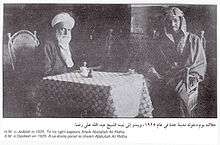
A few months later, Ibn Saud, whose clan originated in the central Nejd province, conquered Medina and Jeddah via an agreement with Jeddans following the Second Battle of Jeddah. He deposed Ali bin Hussein, who fled to Baghdad, eventually settling in Amman, Jordan, where his descendants became part of its Hashemite royalty.
As a result, Jeddah came under the sway of the Al-Saud dynasty in December 1925. In 1926, Ibn Saud added the title King of Hejaz to his position of Sultan of Nejd. Today, Jeddah has lost its historical role in peninsular politics after Jeddah fell within the new province of Makkah, whose provincial capital is the city of Mecca.
From 1928 to 1932, the new Khuzam Palace was built as the new residence of King Abdul Aziz in Jeddah. The palace lies south of the old walled city and was constructed under the supervision of the engineer Mohammed bin Awad bin Laden. After 1963, the palace was used as a royal guest house; since 1995, it has housed the Regional Museum of Archaeology and Ethnography.[22]
The remaining walls and gates of the old city were demolished in 1947. A fire in 1982 destroyed some ancient buildings in the old town center, called Al-Balad, but much is still preserved despite the commercial interest to tear down old houses (Naseef House, Gabil House) and build modern high-rise buildings. A house-by-house survey of the old districts was made in 1979, showing that some 1000 traditional buildings still existed, though the number of structures with great historic value was far less. In 1990, a Jeddah Historical Area Preservation Department was founded.[23][24]
The modern city has expanded wildly beyond its old boundaries. The built-up area expanded mainly to the north along the Red Sea coastline, reaching the new airport during the 1990s and since edging its way around it toward the Ob'hur Creek, some 27 km (17 mi) from the old city center.[25]
Geography
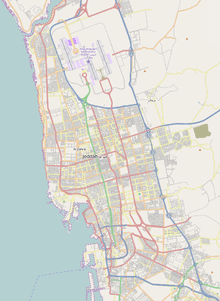
Jeddah is located in Saudi Arabia's Red Sea coastal plain (called Tihamah). Jeddah lies in the Hijazi Tihama (Arabic: تهامة الحجاز) region which is in the lower Hijaz mountains. Historically, politically and culturally, Jeddah was a major city of Hejaz Vilayet, the Kingdom of Hejaz and other regional political entities according to Hijazi history books. It is the 100th largest city in the world by land area.
Climate
Jeddah features an arid climate (BWh) under Koppen's climate classification, with a tropical temperature range. Unlike other Saudi Arabian cities, Jeddah retains its warm temperature in winter, which can range from 15 °C (59 °F) at dawn to 28 °C (82 °F) in the afternoon. Summer temperatures are extremely hot, often breaking the 48 °C (118 °F) mark in the afternoon and dropping to 35 °C (95 °F) in the evening. Summers are also quite steamy, with dew points often exceeding 27 °C (80 °F), particularly in September. Rainfall in Jeddah is generally sparse, and usually occurs in small amounts in November and December. Heavy thunderstorms are common in winter. The thunderstorm of December 2008 was the largest in recent memory, with rain reaching around 80 mm (3 in). The lowest temperature ever recorded in Jeddah was 9.8 °C (49.6 °F) on February 10, 1993.[26] The highest temperature ever recorded in Jeddah was 52.0 °C (125.6 °F) on June 22, 2010.[26]
Dust storms happen in summer and sometimes in winter, coming from the Arabian Peninsula's deserts or from North Africa.
| Climate data for Jeddah (1985-2010) | |||||||||||||
|---|---|---|---|---|---|---|---|---|---|---|---|---|---|
| Month | Jan | Feb | Mar | Apr | May | Jun | Jul | Aug | Sep | Oct | Nov | Dec | Year |
| Record high °C (°F) | 35.0 (95.0) |
36.0 (96.8) |
40.2 (104.4) |
44.5 (112.1) |
48.2 (118.8) |
52.0 (125.6) |
47.0 (116.6) |
46.0 (114.8) |
48.0 (118.4) |
46.4 (115.5) |
40.0 (104.0) |
37.0 (98.6) |
52.0 (125.6) |
| Average high °C (°F) | 29.0 (84.2) |
29.5 (85.1) |
31.8 (89.2) |
34.9 (94.8) |
37.2 (99.0) |
38.3 (100.9) |
39.4 (102.9) |
38.8 (101.8) |
37.6 (99.7) |
36.7 (98.1) |
33.5 (92.3) |
30.7 (87.3) |
34.8 (94.6) |
| Daily mean °C (°F) | 24.5 (76.1) |
24.8 (76.6) |
26.1 (79.0) |
28.5 (83.3) |
30.2 (86.4) |
31.2 (88.2) |
32.7 (90.9) |
32.7 (90.9) |
31.5 (88.7) |
29.8 (85.6) |
27.4 (81.3) |
25.9 (78.6) |
28.8 (83.8) |
| Average low °C (°F) | 20.3 (68.5) |
20.1 (68.2) |
21.4 (70.5) |
22.1 (71.8) |
24.0 (75.2) |
24.8 (76.6) |
26.6 (79.9) |
27.6 (81.7) |
26.4 (79.5) |
24.1 (75.4) |
22.3 (72.1) |
21.0 (69.8) |
23.4 (74.1) |
| Record low °C (°F) | 11.0 (51.8) |
9.8 (49.6) |
10.0 (50.0) |
12.0 (53.6) |
16.4 (61.5) |
20.0 (68.0) |
20.5 (68.9) |
22.0 (71.6) |
17.0 (62.6) |
15.6 (60.1) |
15.0 (59.0) |
11.4 (52.5) |
9.8 (49.6) |
| Average rainfall mm (inches) | 9.9 (0.39) |
3.7 (0.15) |
2.9 (0.11) |
2.8 (0.11) |
0.2 (0.01) |
0.0 (0.0) |
0.3 (0.01) |
0.5 (0.02) |
0.1 (0.00) |
1.1 (0.04) |
26.4 (1.04) |
13.1 (0.52) |
61.0 (2.40) |
| Average relative humidity (%) | 60 | 60 | 60 | 57 | 56 | 58 | 53 | 59 | 67 | 66 | 65 | 63 | 60 |
| Source: Jeddah Regional Climate Center[27] | |||||||||||||
| Jan | Feb | Mar | Apr | May | Jun | Jul | Aug | Sep | Oct | Nov | Dec |
|---|---|---|---|---|---|---|---|---|---|---|---|
| 26.3 °C (79.3 °F) | 25.7 °C (78.3 °F) | 25.8 °C (78.4 °F) | 26.8 °C (80.2 °F) | 28.1 °C (82.6 °F) | 29.0 °C (84.2 °F) | 30.6 °C (87.1 °F) | 31.6 °C (88.9 °F) | 31.1 °C (88.0 °F) | 30.7 °C (87.3 °F) | 29.1 °C (84.4 °F) | 27.9 °C (82.2 °F) |
Economy
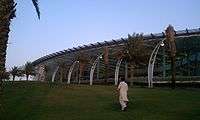
Jeddah has long been a port city. Even before being designated the port city for Mecca, Jeddah was a trading hub for the region. In the 19th century, goods such as mother-of-pearl, tortoise shells, frankincense, and spices were routinely exported from the city. Apart from this, many imports into the city were destined for further transit to the Suez, Africa, or Europe. Many goods passing through Jeddah could not even be found in the city or even in Arabia.[29]
All of the capitals of the Middle East and North Africa are within two hours flying distance of Jeddah, making it the second commercial center of the Middle East after Dubai.[30]
Also, Jeddah's industrial district is the fourth largest industrial city in Saudi Arabia after Riyadh, Jubail and Yanbu.
King Abdullah Street

King Abdullah Street is one of the most important streets in Jeddah and runs from King Fahd Road by the waterfront in the west of Jeddah to the eastern end of the city. It is famous for hosting numerous corporate offices and commercial developments. It will be near the HSR Entrance in Jeddah central train station which connects Jeddah with Makkah, AL-Madinah, and King Adullah Economic City (KAEC). And it also has the tallest flagpole in the world at a height of 170 m (558 ft). This road also faced a catastrophe in 2011 when it was submerged with rainwater.
Tahliyah Street
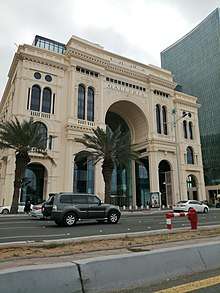
Tahaliyah Street is an important fashion and shopping street in central Jeddah. It contains many upscale department and high fashion brands store as well as boutiques. It has been renamed "Prince Mohammad bin Abdul Aziz Road" by the government, but this official name is not widely used. It also has many fine dining options.
Madinah Road

Madinah Road is a historically significant street in Jeddah. It links the Southern districts with the North, and contains the Main offices of several companies and showrooms. The northern end of the road links to the King Abdul Aziz Int'l Airport, which is a contributing factor to heavy traffic on this road at most times during the day.
Culture
Religious significance
Most citizens are Sunni Muslims. The government, courts and civil and criminal laws enforce a moral code established by Shari'ah. A very small minority of Saudi citizens are Shia Muslims, and there is also a large foreign workforce.
The city has over 1,300 mosques.[31] The law does not allow other religions' buildings, books, icons and expressions of faith. However, private religious observance not involving Muslims nor offending public order and morality is tolerated.
Since the 7th century, Jeddah has hosted millions of Muslim pilgrims from all over the world on their way to Hajj. This merge with pilgrims has a major impact on the society, religion, and economy of Jeddah.
Cultural projects and foundations with a branch in Jeddah
- Encyclopedia of Makkah and Madinah
- Saqifat al-Safa Trust
Cuisine
Jeddah's multi-ethnic citizenry has influenced Jeddah's traditional cuisine.
Some dishes are native to the Hejaz, like Saleeg سَليق and Mabshūr مَبْشُور is a white-rice dish, cooked in broth, often made with chicken instead of lamb meat. Jeddah cuisine is popular as well and dishes like, Foul, Shorabah Hareira (Hareira soup), Mugalgal, Madhbi (chicken grilled on stone), Madfun (literally meaning "buried"), Magloobah, Kibdah, Manzalah (usually eaten at Eid ul-Fitr), Magliya (a local version of falafel) and Saiyadyia which can be acquired in many traditional restaurants around the city, such as Althamrat, Abo-Zaid, Al-Quarmooshi, Ayaz, and Hejaziyat.
Some were imported from other Saudi regions like Kabsa كَبْسَة from Najd, Arīka عَريكة and Ma'sūb مَعْصُوب from the southern Saudi region. Other Dishes were imported from other cultures through Saudis of different origins, like Mantu مَنْتو, Yaghmush يَغْمُش and Ruz Bukhāri رُز بُخاري from Central Asia, Burēk بُريك and Šurēk شُريك and Kabab almīru كباب الميرو from Turkey and the Balkans, Mandi مَنْدي from Yemen, Mutabbag مُطَبَّق from Yemen-Malaysia, Biryāni برياني and Kābli كابلي rice dishes from South Asia.
Grilled meat dishes such as shawarma, kofta and kebab have a good market in Jeddah. During Ramadan, sambousak and ful are especially popular at the evening iftar meal. These dishes are found in Lebanese, Syrian, and Turkish restaurants.
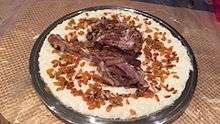
The most popular local fast food chain, begun in 1974, is Al Baik, with branches in Jeddah and the neighbouring cities of Makkah, Madinah and Yanbu. Their main dish is broasted (broiled and roasted) chicken, commonly known by Jeddawis as "Broast", and a variety of seafood.[32] Other local fast food restaurants have sprung up, like Al Tazaj, which serves seasoned grilled chicken (called Farooj) and a side of Tahina with onion and spices. Foultameez serves Foul and Tameez as fast food; Kudu and Herfy serve Western fast food; Halawani serves local variants of Shawerma; and Shawermatak has pioneered drive-through sales of Shawerma. Another popular fast-food chain is Hot and Crispy, an Arabic franchise popular for their spiced curly fries.
Indian, Bangladeshi, Pakistani and other Asian foods are also popular. Italian, French and American restaurants are also to be found.
Open-air art

During the oil boom in the late 1970s and 1980s, there was a focused civic effort led by the then city's mayor Mohamed Said Farsi [33][34] to bring art to Jeddah's public areas. As a result, Jeddah contains a large number of modern open-air sculptures and works of art, typically situated in roundabouts, making the city one of the largest open-air art galleries in the world. Sculptures include works by Jean/Hans Arp, César Baldaccini, Alexander Calder, Henry Moore, Joan Miró and Victor Vasarely. They often depict traditional Saudi items such as coffee pots, incense burners, palm trees, etc. The fact that Islamic tradition prohibits the depiction of living creatures, notably the human form, has made for some very creative, as well as bizarre, modern art. These include a giant geometry set, a giant bicycle, and a huge block of concrete with several cars protruding from it at odd angles and a monumental sculpture by Aref Rayess called "Swords of God (Soyuf Allah)".
Museums and collections
There are about a dozen museums or collections in Jeddah, with varied educational aims and professionalism.[35] These include the Jeddah Regional Museum of Archaeology and Ethnography run by the Deputy Ministry of Antiquities and Museums, the Jeddah Municipal Museum, the Nasseef House, the Humane Heritage Museum, the private Abdul Rauf Hasan Khalil Museum and the private Arts Heritage Museum.
Events and festivals
Red Sea International Film Festival
Jeddah has been selected as a place for the annual Red Sea International Film Festival that will be held in 2020.[36]
Jeddah International Book Fair
Jeddah hosts an annual international book fair called Jeddah international book fair.[37] It is the second largest book fair in Saudi Arabia,[38] and it was first held in 2015. The book fair is held annually in early December.[37]
Jeddah Season
Jeddah Season is a part of the Saudi government's Saudi Seasons initiatives that aims at launching a high-level tourism activities in Saudi Arabia.[39] The first version of the season has been held in June-July 2019.[40] Around 150 activities and events have been organized in five destinations in Jeddah.[40] As Saudi Seasons 2019 aims at shedding the light on the diverse Saudi culture and heritage.[41] Jeddah was chosen because it is one of the most culturally-rich Saudi cities with a history that spans over 3,000 years.[40] Most of Jeddah Season's events and activities have been held at King Abdullah Sports City, Jeddah's historical area, Al-Hamra Corniche, and the Jeddah Waterfront.[42]
Media
Jeddah is served by four major Arabic-language newspapers, Asharq Al-Awsat, Al Madina, Okaz, and Al Bilad, as well as two major English-language newspapers, the Saudi Gazette and Arab News. Okaz and Al-Madina are the primary newspapers of Jeddah and some other Saudi cities, with over a million readers; their focus is mainly local.
Internet blogs specifically informative of locality are abundant in Jeddah, catering mostly to the widespread expatriate population. Of these are constituted websites that have garnered international acclaim for informativeness, such as Jeddah Blog, the recipient of the Bronze Expat Blog Award in 2012 and the Gold Award in 2013 and is among Feedspot's Top 100 Middle East blogs.[43][44] Other amateur websites catering to specific topics in the region exist as well.
Jeddah represents the largest radio and television market in Saudi Arabia. Television stations serving the city area include Saudi TV1, Saudi TV2, Saudi TV Sports, Al Ekhbariya, the ART channels network and hundreds of cable, satellite and other specialty television providers.
The Jeddah TV Tower is a 250 m (820 ft) high television tower with an observation deck.
Accent
The Jeddah region's distinctive speech pattern is called the Hejazi dialect; it is among the most recognizable accents within the Arabic language.
Cityscape
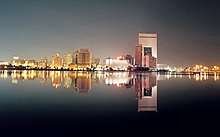
.jpg)
Old Jeddah
The Old City known as Al-Balad with its traditional multistory buildings and merchant houses, that often still belong to the families that inhabited them before the oil-era, has lost ground to more modern developments.[45] Nonetheless, the Old City contributes to Hejazi cultural identity. Since it has been granted UNESCO World Heritage status, in 2014, several traditional buildings have been restored and made open to the public. In 2019, the Saudi crown prince, Muhammad bin Salman, has issued a royal decree that orders The Ministry of Culture to restore 50 historical buildings in Jeddah.[46] Several historic mosques from different eras are located in al-Balad, as well as one of oldest museums in the city, called Bayt Naseef or Naseef house, displaying local furniture and interior design of the past 150 years, approximately.
Resorts and hotels
The city has many popular resorts, including Durrat Al-Arus, Al-Nawras Mövenpick resort at the Red Sea Corniche, Crystal Resort, Radisson Blu, The Signature Al Murjan Beach Resort, Al Nakheel Village, Sands, and Sheraton Abhur. Many are renowned for their preserved Red Sea marine life and offshore coral reefs.
Consulates
One of two consulates of the United States of America in Saudi Arabia is located in Jeddah, along with the consulates for 67 other countries such as Afghanistan, the United Kingdom, Indonesia, France, Germany, Greece, Turkey, Philippines, India, Pakistan, Bangladesh, Italy, Russia and People's Republic of China. Some of the other consulates present include, countries of the Organisation of Islamic Cooperation and the Arab League states.
Historical Jeddah
.jpg)
Historical Jeddah is situated on the eastern shore of the Red Sea. From the 7th century AD it was established as a major port for Indian Ocean trade routes, channelling goods to Mecca. It was also the gateway for Muslim pilgrims to Mecca who arrived by sea. These twin roles saw the city develop into a thriving multicultural centre, characterized by a distinctive architectural tradition, including tower houses built in the late 19th century by the city's mercantile elites, and combining Red Sea coastal coral building traditions with influences and crafts from along the trade routes.[47]
.jpg)
Within a defensive wall that was built during Ottoman rule, the old city of Jeddah, Al-Balad, was divided into districts, or Haras, where business and trade centred around traditional souks, or market places, and khans, covered markets that were generally connected to shops.[48]
Harrat Al-Mathloum (District of the Wronged)
Located in the North East, this district was named after Abdulkarim Al-Barzangi, a Hijazi rebel who was crucified by the Ottomans, some of its landmarks are:
- Dar Al-Qabil
- Dar Al-Ba'ashin
- Dar Al-Sheikh
- Al-Shafi'i Mosque
The oldest mosque in town, its minaret was built in the 13th century, and its pillars date back to Ottoman rule.
- Mosque of Uthman bin Affan
Also called the Ebony Mosque because of its two ebony pillars, it was mentioned in the writings of Ibn Battuta and Ibn Jubayr.
- Al-Mia'mar Mosque
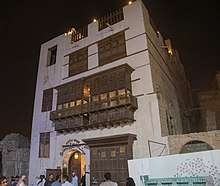
An old mosque built in the 17th century.
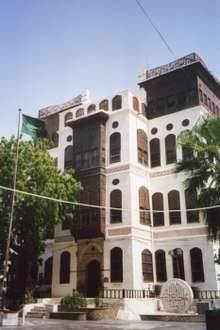
- Souq Al-Jama
One of the oldest markets in town.
Harrat Al-Sham (The Levantine District)
Located in the north and named after its orientation, some of its landmarks are:
- Dar Al-Sadat
- Dar Al-Serti
- Dar Al-Zahid
- Dar Al-Banajah
- Al-Basha Mosque
Built by Bakr Basha, the governor of Jeddah in 1735.
Harrat Al-Yemen (The Yemeni District)
Located in the south and is also named after its orientation, its landmarks include:
- Beit Nasseef
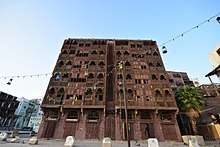
By far the most famous site in the old town, it was built in 1881 for Omar Nassif Efendi, governor of Jeddah at the time, and served as the royal residence of King Abdulaziz after conquering the city.
- Dar Al-Jamjom
- Dar Al-Sha'araoui
- Dar Al-Abdulsamad
- Dar Al-Kayal
- Beit Al-Matbouli
- Beit Al-Joghadar
Harrat Al-Bahar (The Seafront District)
Located in the south west, some of its landmarks are:
- Dar Al-Nas
- Dar Al-Radwan
- Dar Al-Nimr
Landmarks
Abdul Raouf Khalil Museum
Founded by Sheikh Abdul Raouf Khalil in 1996, this museum not only presents the rich Islamic cultural heritage of the city but also its preislamic history that goes back to 2500 years; it traces the various civilizations that inhabited the region. Located in the downtown district, it boasts of large collection of items and artifacts belonging to the Ottoman Turks and the fishermen tribes who were the first inhabitants of the region.[49]
King Fahd's Fountain
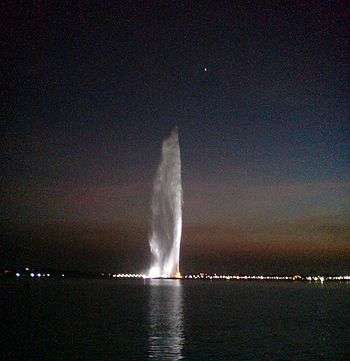
King Fahd's Fountain was built in the 1980s, can be seen from a great distance and, at 312 metres (1,024 ft), is the highest water jet in the world according to the Guinness World Records.[50] The fountain was donated to the City of Jeddah by the late King Fahd bin Abdul Aziz, after whom it was named.
Al-Rahmah Mosque
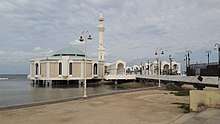
Sometimes referred to as the floating mosque because of it being built above water, this fascinating mix of the old architecture and the new was built in 1985. It is a popular spot among tourists and natives looking to lounge by the seaside.
Al-Jawhara Stadium
Is a new stadium launched in 2014, located north of Jeddah, is used mostly for football, reaching a full capacity of 62,241 spectators. It is the largest stadium in Jeddah, and the second largest in Saudi Arabia.
King Saud Mosque
The largest mosque in the city. Built in 1987, it displays beautiful Islamic architecture and was built by Egyptian architect Abdel Wahed El Wakil.[51]
NCB Tower
Built in 1983 and believed to be the highest tower in Saudi Arabia during the 1980s, with a height of over 235 m (771 ft), the National Commercial Bank was Saudi Arabia's first bank.

IDB Tower
The Islamic Development Bank is a multilateral development financing institution. It was founded by the first conference of Finance Ministers of the Organisation of the Islamic Conference (OIC, now the Organisation of Islamic Cooperation), convened 18 December 1973. The bank officially began its activities on 20 October 1975.
Jeddah Municipality Tower
This is the headquarters of the metropolitan area of Jeddah. The municipality's new building is going to be not only Jeddah's tallest but is also going to dethrone the Burj Khalifa.
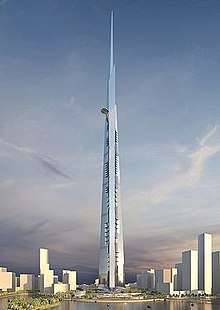
This proposed tower, formerly known as the Kingdom Tower, is being built in Jeddah by Prince Al-Waleed bin Talal and will stand 1-kilometre (0.62 mi) tall. Upon its completion, it will be the tallest skyscraper in the world. The building has been scaled down from its initial 1.6 km (1 mi) proposal, since the ground proved unsuitable for a building that tall, to a height of at least 1,000 metres (3,280.84 ft) (the exact height is being kept private while in development, similar to the Burj Khalifa),[52] which, at about one kilometre (0.62 miles), would still make it by far the tallest building or structure in the world to date,[53] standing at least 173 m (568 ft) taller than the Burj Khalifa in Dubai. Construction began in April 2013 and is scheduled for completion in 2019.[54]
King Road Tower
King Road Tower is a commercial and office building, the external walls of which are used to show commercials. The building also has a helipad on its roof. King Road Tower has the largest LED display in the world on its walls.
Al Jawharah Tower
Al Jawharah Tower is a residential high-rise under construction. It became the third-tallest structure in Jeddah when completed in 2014.
Jeddah Flagpole
The King Abdullah Square on the intersection of Andalus Road with King Abdullah Road has the world's tallest flagpole. It is 171 metres (561 feet) high and the Saudi flag atop it weighs 570 kilograms (1,260 pounds). On the 84th Saudi Arabia National Day, September 23, 2014, the flagpole hoisted a huge Saudi flag before a crowd of thousands. The flagpole succeeded Dushanbe Flagpole as the tallest flagpole in the world.[55]
Entrance of Mecca
Bab Makkah, also known as Makkah Gate, is a limestone coral gateway that leads into the historic Al-Balad district of Jeddah.
The Mecca Gate, named the "Quran Gate", is located 60 km outside Jeddah on the Makkah Mukkarram road of the Jeddah - Mecca Highway. It is the entrance to Mecca and the birthplace of Muhammad. The gate signifies the boundary of the haram area of the city of Mecca, where non-Muslims are prohibited to enter. The gate was designed in 1979 by an Egyptian architect, Samir Elabd, for the architectural firm IDEA Center. The structure is that of a book, representing the Quran, sitting on a rehal, or book stand.[56]
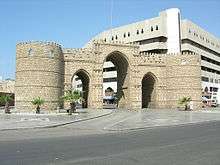
Jeddah Waterfront
The new waterfront was inaugurated November 2017, by Makkah Governor, Prince Khaled Al-Faisal.[57]
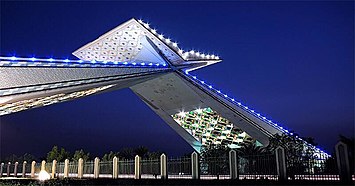
It spans an area of 730,000 kilometres on the Red Sea. It has many facilities including: swimming beaches, huts, floating marina dock, washrooms, restaurants, parks, dancing fountains, playgrounds and access to wifi.[58]
This project of developing JW (Jeddah Waterfront) has been awarded as Jeddah Innovation Award of the year 1439H in the field of government innovation, by the province of Jeddah.[59][60]
Education
Schools, colleges and universities
As of 2005, Jeddah had 849 public and private schools for male students and another 1,179 public and private schools for female students.[61] The medium of instruction in both public and private schools is typically Arabic, with emphasis on English as a second language. However, some private schools administered by foreign entities conduct classes in English. These include 10+ Indian schools following the CBSE board of education system, several Pakistani and Bangladeshi schools as well. As of 2005, Jeddah also had four Philippine international schools, with two more scheduled to open shortly afterward.[62]
Jeddah's universities and colleges include the following:
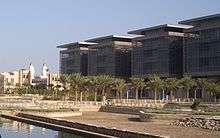
- King Abdulaziz University
- King Abdullah University of Science and Technology
- University of Jeddah
- Arab Open University
- Dar Al-Hekma College
- Effat University
- University of Business and Technology (UBT)
- Teacher's College
- Jeddah College of Technology
- Jeddah Private College
- College of Health Care
- College of Telecom & Electronics
- College of Community
- Private College of Business
- Ibn Sina National College for Medical Studies
- Batterjee Medical College
- Prince Sultan College of Tourism
- Prince Sultan Aviation Academy
- Islamic Fiqh Academy
- Jeddah Institute for Speech and Hearing
- Saudi German Institute for Nursing
Jeddah is also home to several primary, intermediate and secondary schools such as:
Italian international school
- Jeddah International School
- Zahrat Al-Sahraa International school (ZSIS)
- Cedar International School
- British International School of Jeddah (Continental, BISJ)
- École Française Internationale de Djeddah
- German International School Jeddah
- Al-Thager Model School
- International Indian School Jeddah (IISJ)
- Pakistan International School Jeddah (PISJ)
- DPS Jeddah Al-Falah International School
- International Philippine School in Jeddah
- Jeddah Japanese School
- Korean International School of Jeddah (KISJ; 젯다한국국제학교)[63]
- Al-Waha International School
- Beladi International School Jeddah
- Yusr International School
- Al-Afaq International School
- Manarat Jeddah Schools
- Gharnatah International School
- New Al Wurood International School Jeddah [NAWIS]
- Bangladesh International School Jeddah (BISESJ)
- Bader International School
- Nobles International School (NIS)
- Dauha Al Uloom International School (DAUISJ)
- Al-Fath Schools
- Al-Aqsa Private Schools
- Dar Al-Fikr Schools (DAF)
- Al-Fanar School Jeddah
- Dar Al-Thikr Schools
- Hala International School (HIS)
- Jeddah International Turkish School (JITS)
- Jeddah Prep and Grammar School (JPGS)
- Al Hamraa Girls' School
- Building Blocks (private school)
- Dar Jana International School (DJIS)
- Al Mawarid International School Jeddah [AMIS]
- Pioneer International School
- Duaa International School Jeddah (DISJ)
- Jeddah Private School (JPS)
- Nhaond School
- Number 18 High School
- Number 25 Secondary School
- Tuletelah High School
- Bangladesh International School And College (Bangla Section) Jeddah (BISCJ)
- Al-Afkar International School
- Waad Academy School
- Al Kon International School
Libraries
The central library at King Abdulaziz University (main branch) is a five story building that has a large collection of Arabic and English language books, rare books and documents as well as access to several online databases. It is open for public access and allows borrowing of books after requesting a library card. Saturdays are dedicated for female visitors.[64]
King Abdul Aziz Public Library is a philanthropic institution which was founded and supported by the Custodian of the Two Holy Mosques King Abdullah Bin Abdulaziz, chairman of its board of directors. Established in 1985, the library was officially opened by the King on 27 February 1987. It emphasises Islamic and Arabic heritage and history of the Kingdom. The library is divided into three branches (men's, women's, and children's).[65]
The limited number of libraries is criticized by the public. As a result, King Abdullah, Custodian of the Two Holy Mosques, has approved the King Abdullah Project for the Development of Public Libraries, and approximately SAR150 million is budgeted to be spent.[66]
In April 2014, Prince Mishaal Ibn Abdullah Abdulaziz opened a new public library in Jeddah by Makkah Governor, under the name of King Fahd Public Library.[67]
King Fahd Public Library was built over an area of 17,000-square-meter within the main Campus of King Abdulaziz University (KAU) in Jeddah. it includes a diverse collection of books and reference material classified into three sections to meet the needs and wants of a wide range of readership. Spaces have been set apart for youths, children and women.[67]
Sports
Jeddah is the home of 2 biggest well-known football clubs teams Al-Ittihad Club (Jeddah) and Al-Ahli Saudi FC. Both teams play their league matches at King Abdullah Stadium which is located northern part of Jeddah nearby King Abdelaziz Airport
The city is home to the 2015 Saudi Arabian basketball Champion Al-Ittihad Jeddah, which plays its home games in the Prince Abdullah Al-Faisal Basketball Arena.[68]
Wellness
The population of Saudi Arabia and especially Riyadh and Jeddah has seen health issues growing due to urbanization. Cancers, diabetes and other diseases are increasing. Disease prevention is a new market and ÃLOKA Wellness is helping Jeddah's residents to get back in health and shape.
Transport
Airport
Jeddah is served by King Abdulaziz International Airport. The airport has four passenger terminals. One is the Hajj Terminal, a special outdoor terminal covered by large white tents, which was constructed to handle the more than two million pilgrims who pass through the airport during the Hajj season. The Southern Terminal is used by Saudia and Flynas (both based in Saudi Arabia), while the Northern Terminal serves foreign airlines. A plan for the extension of the airport is being developed. The Royal Terminal is a special terminal reserved for VIPs, foreign kings and presidents, and the Saudi royal family. A portion of the airport, King Abdullah Air Base, was used by Coalition B-52 heavy bombers during Operation Desert Storm in 1991.
Before King Abdulaziz Airport opened in 1981, Kandara Airport served Jeddah. It was at Kandara, a neighborhood very near the town center. However, the old Jeddah airport experienced heavy congestions, especially during hajj seasons.[69] After the airport became defunct, the area was redeveloped for housing.[70]
Seaport
The Jeddah Seaport is the 32nd busiest seaport in the world as of 2008. It handles the majority of Saudi Arabia's commercial movement.
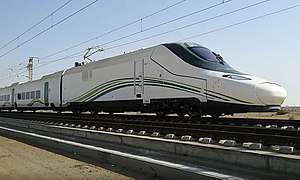
In 2017 Jeddah seaport handled 4,309,765 TEUs and in the year 2018 handled 4,215,248 TEUs.
Road and rail
Highway 40, which begins in Jeddah, connects the city to Mecca, Riyadh and Dammam on the east coast. Jeddah does not have any rapid transit system, but a rail system connecting the city to Riyadh is now under construction. The Haramain High Speed Rail Project will provide a connection to Mecca and Medina.[71] There is a contracted plan to build an extensive light metro system known as the Jeddah Metro, throughout the city by 2020.[72] Jeddah's main highways run parallel to each other.
Issues and challenges
The city is challenged by pollution, weak sewage systems, a weak storm drain system that led to massive floodings, heavy traffic, epidemics, and water shortages.
Pollution and environment
Air pollution is a problem for Jeddah, particularly on hot summer days. The city has experienced bush fires, landfill fires, and pollution from the two industrial zones in the north and the south of the metropolitan area. A water treatment factory and the seaport also contribute to water pollution. Much of the seafront, however, is considered to be safe and clean. Ramboll has acted as Environmental Consultant on the Jeddah Environmental Impact Assessment as well as the Jeddah Environmental Social Masterplan.[73]
Terrorism
On 6 December 2004, a group of five men associated with the terrorist group Al-Qaeda (Al-Qaeda Organization in the Arabian Peninsula) conducted a mid-day attack on the U.S. Consulate, which killed five Consulate workers. The group was led by Fayez ibn Awwad Al-Jeheni, a former member of Saudi religious police. Two other assailants were subsequently identified by the Saudi authorities as residents of Jeddah's Al-Jamia suburb and other slums on Saudi Arabia's increasingly urbanised west coast. Buildings were attacked, hostages taken and used as human shields, and the U.S. and non-U.S. staff were under siege, although the chancery/consular section building itself was never penetrated.[74] Closed circuit video feeds documented that the Saudi security personnel assigned to protect the facility fled when the vehicle holding the terrorists pulled up to the front gate and ran past the Delta barrier.[75] Inside the compound, however, an armed Saudi security guard employed by the embassy shot and killed one terrorist before being fatally shot himself.
The attackers spread and ignited a flammable liquid on the front of the chancery building, and opened fire on the front doors, both of which actions did not have any penetrating effect. The Consulate's U.S. Marines released tear gas in front of the chancery building, but the terrorists had already left that location. More than an hour later, Saudi special forces made it through traffic and, along with others from their unit who arrived in a helicopter, fought to retake the compound. Two of the terrorists were killed in the final fight, with another dying later in hospital and the final militant being captured alive. Four Saudi special forces and a further 10 hostages were wounded in the crossfire.[74][76][77]
The five Foreign Service National employees who died during the terrorist attack were Ali Yaslem Bin Talib, Imad e-Deen Musa Ali, Romeo de la Rosa, Mohammed Baheer Uddin and Jaufar Sadik. The casualties came from Yemen, Sudan, Philippines, India and Sri Lanka.[78]
The attack underscores the ongoing vulnerabilities of Westerners to threats and terrorist actions in Jeddah and environs. In a communiqué posted in online publications such as Sawt al-Jihad (Voice of Jihad) and Mu'askar al-Battar (Al-Battar Training Camp), Al-Qaeda hinted at the symbolic nature of the U.S. Consulate attack, stating: "Know that the Mujahideen are determined to continue on their path, and they will not be weakened by what has happened to them."[74]
Terrorist activities have persisted from 2004 to the present day. In 2004 there was an unsuccessful shooting attack on a U.S. Marine visiting the Saudi American Bank and an attempt to simultaneously explode car bombs at Saudi American Bank and Saudi British Bank branches in Jeddah on the anniversary of the 2001 "9-11" terrorist attacks on the U.S.[79] On 26 August 2012, a spokesman for the Interior Ministry announced that terrorists were arrested in Jeddah who had been preparing explosives for attacks within the kingdom.[80]
Traffic
Roads and highways within and exiting the city are frequently clogged with traffic. Mass transit is rare and planning is nascent; most Jeddawi adults have at least one car. Motorcycles are rare on the roads, further impacting the traffic patterns. Days immediately preceding and following the holy days are particularly noisome and cost hundreds of thousands many hours because of traffic jams. The Saudi Gazette reports that there is a plan in the works to tackle the traffic issue. A reported 3 billion Saudi Riyals will be put into constructing flyovers and underpasses in an effort to expedite traffic. The plan is scheduled to take about five years from its start to finish.[81]
Sewage
Prior to the construction of a waste treatment plant, Jeddah's waste water was disposed of by either discharge into the sea or via absorption into deep underground pits. As the city grew, a proper waste management plant was created and the built up part of the city was connected with a sewer system by the 1970s. However, even with the ever-increasing population, the original sewer system has hardly been expanded. The original plant cannot cope with the amount of waste inundating it daily. As a result, some untreated sewage is discharged directly into the sea and the entire northern part of the city remains completely unconnected to the sewage system, instead relying on septic tanks. This has been responsible for the large number of sewage tankers.
In late 2011, a storm drainage system was built in the south Jeddah area (similar to that of the Los Angeles storm drain) to reduce the risk of floods.[82]
Floods

On 25 November 2009, heavy floods affected the city and other areas of Makkah Province.[83][84] The floods were described by civil defence officials as the worst in 27 years.[85] As of 26 November 2009, 77 people were reported to have been killed,[86] and more than 350 were missing.[83] Some roads were under a metre (three feet) of water on 26 November, and many of the victims were believed to have drowned in their cars. At least 3,000 vehicles were swept away or damaged.[83][86][87] The death toll was expected to rise as flood waters receded, allowing rescuers to reach stranded vehicles.[88]
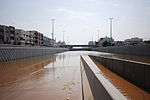
On 26 January 2011, again, heavy floods affected the city and other areas of Makkah Province. The cumulative rainfall exceeded the 90 mm (3.5 in) recorded in four hours during the 25 November 2009 flash floods. Streets including Palestine Street, Madinah Road and Wali Al-Ahad Street were either flooded or jammed with traffic. Cars were seen floating in some places. Meanwhile, eyewitnesses told local newspaper Arab News that East Jeddah was swamped and floodwater was rushing west towards the Red Sea, turning streets into rivers once again.
On 17 November 2015, heavy floods affected the city. Streets affected by the flood include Palestine Street, Madinah Road and many others. Cars were seen burning, and many trees fell as a result of the violent flood.[89] 3 deaths were also reported. 2 of the fatalities (including a child) were hit by lightning while crossing a street.
On 21 November 2017, heavy floods affected the city once more and Jeddah Islamic Port stopped operations for about 3 hours. Jeddah police received 11,000 phone calls on 911 from people enquiring about alternative roads and weather conditions.[90] There were 250 reports of electrocution. Five people were electrocuted, two died.
Districts
Metropolitan Jeddah comprises 137 districts: (transliterated from Arabic)
- Al-Murjan
- Al-Basateen
- Al-Mohamadiya
- Ash-Shati
- An-Nahda
- An-Naeem
- An-Nozha
- Az-Zahraa
- As-Salamah
- Al-Bawadi
- Ar-Rabwa
- As-Safa
- Al-Khalidiya
- Ar-Rawdha
- Al-Faysaliya
- Al-Andalus
- Al-Aziziya
- Ar-Rihab
- Al-Hamraa
- Al-Mosharafa
- Ar-Ruwais
- Ash-Sharafiya
- Bani Malik
- Al-Woroud
- An-Naseem
- Al-Baghdadiya Ash-Sharqiya
- Al-Amariya
- Al-Hindawiya
- As-Saheifa
- Al-Kandra
- As-Sulaimaniya
- Al-Thaalba
- As-Sabeel
- Al-Qurayat
- Gholail
- An-Nozla Al-Yamaniya
- Al-Nozla Ash-Sharqiya
- Al-Taghr
- Al-Jamaa
- Madayin Al-Fahad
- Ar-Rawabi
- Al-Wazeeriya
- Petromin
- Al-Mahjar
- Prince Abdel Majeed
- Obhour Al-Janobiya
- Al-Marwa
- AL-Fayhaa
- King Abdul Al-Aziz University
- Al-Baghdadiya Al-Gharbiya
- Al-Balad
- Al-Ajwad
- Al-Manar
- As-Samer
- Abruq Ar-Roghama
- Madinat As-Sultan
- Um Hablain
- Al-Hamdaniya
- Al-Salhiya
- Mokhatat Al-Aziziya
- Mokhatat Shamal Al-Matar
- Mokhatat Ar-Riyadh
- Mokhatat Al-Huda
- Braiman
- Al-Salam
- Al-Mostawdaat
- Al-Montazahat
- Kilo 14
- Al-Harazat
- Um As-Salam
- Mokhtat Zahrat Ash-Shamal
- Al-Majid
- Gowieza
- Al-Gozain
- Al-Kuwait
- Al-Mahrogat
- Al-Masfa
- Al-Matar Al-Gadeem (old airport)
- Al-Bokhariya
- An-Nour
- Bab Shareif
- Bab Makkah
- Bahra
- Al-Amir Fawaz
- Wadi Fatma
- Obhour Shamaliya
- At-Tarhil (deportation)
- Al-Iskan Al-janoubi
- At-Tawfeeq
- Al-Goaid
- Al-Jawhara
- Al-Jamoum
- Al-Khumra
- Ad-Difaa Al-Jawi (Air Defense)
- Ad-Dageeg
- Ar-Robou
- Ar-Rabie
- Ar-Rehaily
- As-Salmiya
- As-Sanabil
- As-Sinaiya (Bawadi)
- Industrial City (Mahjar)
- Al-Adl
- Al-Olayia
- Al-Faihaa
- Al-Karanteena
- Al-Ajaweed
- Al-Ahmadiya
- Al-Mosadiya
- East Al-Khat As-Sarei
- Kilo 10
- King Faisal Navy Base
- Kilo 7
- Kilo 45
- King Faisal Guard City
- Kilo 11
- Thowal
- Kilo 13
- Al-Makarona
- Al-Layth
- Al-Gonfoda
- Rabegh
- Kilo 8
- Kilo 5
- Kilo 2
- Al-Mokhwa
- National Guard Residence
- As-Showag
- Air Defense Residence
- Al-Morsalat
- Ash-Shoola
- Al-Corniche
- Al-Waha
- Mokhatat Al-Haramain
- Kholais
- Al-Rhmanya
- Wadi al batin
- AL MADINAH
- JUDAYYIADAT ARAR
- AS SALWA
Twin towns – sister cities
Jeddah has 35 sister cities (or "twin towns") which are selected based on economic, cultural and political criteria.





























Notes
- "FaceOf: Saleh Ali Al-Turki, mayor of Jeddah". Arab News. 2018-07-31. Retrieved 2019-02-05.
- "Population". Statistical Yearbook 50 (2014). Central Department Of Statistics & Information. Archived from the original on 21 February 2016. Retrieved 21 February 2016.
- "population of the administrative region of Makkah" (PDF). General authority of statistics.
- "The Saudis may be stretching out the hand of peace to their old foes". The Economist. 7 September 2017. Retrieved 10 September 2017.
- "Archived copy". Archived from the original on 2012-07-01. Retrieved 2010-07-28.CS1 maint: archived copy as title (link)
- "2thinknow Innovation Cities™ Emerging 11 Index 2009 - Middle East, Africa and Former USSR States | 2009". Innovation-cities.com. 2009-11-12. Retrieved 2011-04-17.
- Jayussi, Salma; Manṣūr Ibrāhīm Ḥāzimī; ʻIzzat ibn ʻAbd al-Majīd Khaṭṭāb Beyond the Dunes I B Tauris & Co Ltd (28 April 2006), p. 295. ISBN 978-1-85043-972-1
- Ibn Battota's Safari. Tuhfat Al-Nothaar Fe Gharaa'ib Al-Amsaar. Chapter: "From Cairo to Hejaz to Tunisia again". ISBN 9953-34-180-X
- British Embassy website
- "Lost in translation." Brian Whitaker. Guardian (UK). 10 June 2002.
- "Archived copy". Archived from the original on 2016-09-20. Retrieved 2016-08-08.CS1 maint: archived copy as title (link)
- History of Jeddah. Ministry of Hajj.
- "صحيفة عكاظ - جدة اليوم.. والعم وهيب". Okaz.com.sa. Archived from the original on 2016-03-03. Retrieved 2011-04-17.
- alalamonline (2010-03-10). "Alamlam Online". alalamonline.net. Archived from the original on 2013-10-29. Retrieved 2013-08-13.
- Cooper, Tom (2015-04-19). Wings over Ogaden. Helion and Company. p. 5. ISBN 9781909982383. Retrieved 16 February 2016.
- صحيفة عكاظ (2012-06-05). "صحيفة عكاظ - مقبرة النصارى". Okaz.com.sa. Archived from the original on 2013-04-29. Retrieved 2013-03-26.
- Whiteway, R. S. (June 1995). Rise of Portuguese Power in India Por R. S. Whiteway. ISBN 9788120605008.
- "History of Arabia." Britannica.com.
- Makkah Gate in Jeddah. AsiaRooms.com.
- Caudill, Mark A. (2006). Twilight in the kingdom : understanding the Saudis. Westport, Conn.: Praeger Security International. p. 133. ISBN 9780275992521.
- Bosworth, C. Edmund (2007). Historic cities of the Islamic world. Leiden: Brill. p. 223. ISBN 9789004153882. Retrieved 6 August 2015.
- Leaflet for Khuzam Palace Jeddah, Deputy Ministry of Antiquities & Museums
- "Preserving Jeddah's Historic Buildings." Archived 2010-01-29 at the Wayback Machine Saudi Arabia, Winter 1999, Volume 15, Number 4. Information Office, Royal Embassy of Saudi Arabia.
- The Biet Nassif in Jeddah at asiarooms.com
- Maneval, Stefan. 2019. New Islamic Urbanism. London: UCL Press, 31–36.
- "Climate Normals for Jeddah". Jeddah Regional Climate Center. Archived from the original on 12 May 2012. Retrieved 1 February 2013.
- "Climate Data for Saudi Arabia". Jeddah Regional Climate Center. Archived from the original on May 12, 2012. Retrieved December 7, 2015.
- "Monthly Jeddah water temperature chart". Seatemperatures.org. Retrieved 2014-01-20.
- Al-Sha'afi, Muhammad (1990). Foreign Trade of Juddah: During the Ottoman Period 1840-1916. King Saud University.
- Commerce of Jeddah. Saudi Arabian Water & Power Forum.
- Report about number of mosques. Al-Sharq Al-Awsat Newspaper.
- "Al Baik fast food". Albaik.com. Retrieved 2015-03-04.
- Jones, Jonathan (2015-06-01). "Sculptural oasis: why the giants of art made for Jeddah". the Guardian. Retrieved 2018-05-22.
- Park, Jeddah Sculpture. "Sculptures of Jeddah". www.sculpturesofjeddah.com. Retrieved 2018-05-25.
- Museums in Jeddah at asiarooms.com
- "Red Sea International Film Festival: Saudi Arabia announces new Jeddah event". The National. Retrieved 2019-04-23.
- "Jeddah international book fair". Jeddah International Book Fair. Retrieved 2019-05-08.
- "Saudi Arabia's 4th Jeddah International Book Fair set for 13 days over western Christmas and New Year". The New Publishing Standard. 2018-12-17. Retrieved 2019-05-08.
- K, Yara (2019-03-01). "'Saudi Seasons 2019' Initiative: Mapping the Way for Tourism". WHATSUP KSA. Retrieved 2019-06-11.
- "Jeddah Season announces fun-filled calendar". Saudigazette. 2019-06-02. Retrieved 2019-06-11.
- "Launching the "Saudi Seasons 2019" Program". scth.gov.sa. Retrieved 2019-06-11.
- "Jeddah's Kanz Al-Balad, Al-Ozwa Street Performance enthrall visitors". Arab News. 2019-06-16. Retrieved 2019-06-18.
- "Expat Blog Awards 2013". Jeddah Blog. Retrieved 24 May 2015.
- "Top 100 Middle East Blogs & Websites to Follow in 2020 | Mideast Blogs". September 2017.
- Maneval, Stefan. 2019. New Islamic Urbanism. London: UCL Press, 38–9.
- K, Yara (2019-05-13). "Crown Prince Orders Restoration Processes Of Historical Buildings". WHATSUP KSA. Retrieved 2019-06-11.
- Centre, UNESCO World Heritage. "Historic Jeddah, the Gate to Makkah". whc.unesco.org. Retrieved 2017-09-04.
- Krause, Rolf Friedrich (1991). Stadtgeographische Untersuchungen in der Altstadt von Djidda. Bonn: F. Dümmler. pp. 53–6. ISSN 0373-0468.
- "Abdul Raouf Khalil Museum of Jeddah | SILK ROAD". en.unesco.org. Retrieved 2017-09-05.
- Photograph of King Fahd Fountain at treklens.com
- Mirza, Mohammed. "The Egyptian Architect Who Has Designed Saudi Arabia's Most Famous Mosques". Retrieved 2020-05-09.
- Khan, Ghazanfar Ali; Abbas, Maher (3 August 2011). "Kingdom Holding to build world's tallest tower in Jeddah". Arab News. Archived from the original on August 9, 2011. Retrieved 10 August 2011.
- AFP (13 March 2008). "Saudi mile-high tower plan raises bar". The Australian. Archived from the original on 7 March 2009. Retrieved 3 August 2011.
- "Kingdom Tower: Tallest of the tall". The Chicago Tribune. 2 August 2011. Retrieved 2 August 2011.
- Saudi Gazette, "Saudi flag flies high on world's tallest flagpole" Archived 2014-09-08 at the Wayback Machine, Saudi Gazette, 2014-06-01
- IDEA Center Projects – Makkah Gate
- Makkah governor opens Jeddah's new waterfront – Arab news
- New Jeddah Waterfront open for visitors – Gulf News
- "Jeddah".
- Gilian (2017-12-10). "Jeddah Waterfront (Corniche)". Words and Wonders. Retrieved 2019-01-29.
- Statistical summary of education in Saudi Arabia. Statistical Information Department of the Ministry of Education.
- Salud, Francis R. "2 More Filipino Schools to Open in Jeddah" (Archive). Arab News. Thursday 7 March 2005. Retrieved on 5 November 2015.
- "Home." Korean International School of Jeddah (젯다한국국제학교). Retrieved on September 21, 2015. "주소 : P.O.BOX 4322, Jeddah 21491, Kingdom of Saudi Arabia."
- "Deanship of Library Affairs".
- "King Abdul Aziz Library". Kapl.org.sa. 1987-02-27. Archived from the original on 2013-09-17. Retrieved 2013-03-26.
- Saudi Gazette. "King gives the go-ahead to develop public libraries". Saudi Gazette. Archived from the original on 2013-07-28. Retrieved 2013-03-26.
- "King Fahd Public Library inaugurated". www.kau.edu.sa. Retrieved 2019-01-29.
- Ittihad captures Saudi basketball crown Saudi Gazette, 1 June 2016. Accessed 9 June 2016
- Airways: A Global Review of Commercial Flight. Airways International. 2008.
Jeddah's first airport at Kandara, located very close to the city center, used to handle all Hajj traffic in addition to normal scheduled operations. But the airport's limited capacity and infrastructure tended to cause tremendous congestion problems, notably when, by 1978, daily aircraft movements during the Hajj season reached a critical level of 600 per day. In May 1981 Kandara was ...
- Weekly Bulletin. Institut du transport aérien. 1981. p. 683.
the new airport replaces that of Kandara which had undergone many transformation operations in recent years and is to be converted into a real estate development zone.
- "Al Rajhi wins Makkah - Madinah civils contract". Railway Gazette International. 2009-02-09. Archived from the original on 2012-04-15. Retrieved 2009-08-10.
- "Jeddah Metro project will be ready by 2020". Saudi Gazette. 10 August 2014. Retrieved 6 April 2015 – via Al Arabiya.
- "Urban liveability calls for urgent action". Retrieved 27 February 2017.
- "JTIC Briefing". Retrieved 24 May 2015.
- "2005 Jeddah ARB Recommended "Remote Safe Areas" for Embassies – Upgrades Coming … Or Maybe Not « Diplopundit". Diplopundit. 16 April 2013. Retrieved 24 May 2015.
- "1st Anniversary of Attack on US Consulate - Rasheed's World". 6 December 2005. Retrieved 24 May 2015.
- "Saudi cleric condemns consulate attack - World news - NBC News". msnbc.com. 8 December 2004. Retrieved 24 May 2015.
- "Terror Attack on U.S. Consulate Jeddah « Diplopundit". Retrieved 24 May 2015.
- "Terrorism – Saudi Arabia - SUSRIS". Archived from the original on 2 July 2015. Retrieved 24 May 2015.
- "LexisNexis News". LexisNexis. Retrieved 29 August 2012.
- Al-Siqqiqui, Saoud. "SR3b to tackle Jeddah traffic over five years". Saudi Gazette. Archived from the original on 13 September 2012. Retrieved 11 April 2011.
- Vincent, Peter (2003). "Jeddah's Environmental Problems". Geographical Review. The Geographical Review. 93 (3): 394–412. doi:10.1111/j.1931-0846.2003.tb00039.x.
- "Saudi Arabian floods kill 77, leave scores missing". Agence France Presse. 26 November 2009. Retrieved 2009-11-26.
- "Saudi Arabia floods leave 48 dead". BBC News. 26 November 2009. Retrieved 26 November 2009.
- Anqawi, Ayman (26 November 2009). "Flooding kills 77 in Jeddah, Thousands of pilgrims stranded on highway". Saudi Gazette. Archived from the original on 30 November 2009. Retrieved 2009-11-26.
- Alawi, Ibrahim; Al-Harthi, Eid (27 November 2009). "King orders aid for victims, Death toll in Jeddah flooding hits 77". Saudi Gazette. Archived from the original on 2 March 2012. Retrieved 2009-11-27.
- Al-Zahrani, Saleh (26 November 2009). "Damage may top SR1 billion". Saudi Gazette. Archived from the original on 20 May 2010. Retrieved 2009-11-27.
- Humaidan, Muhammad (27 November 2009). "Jeddah flood death toll reaches 77". Arab News. Retrieved 2009-11-27.
- "Saudi Arabia urges all Jeddah residents to remain indoors". 16 November 2015.
- Muhammad, Fatima (2017-11-21). "Jeddah rains flood streets, met office near airport hit by lightning". Saudigazette. Retrieved 2017-11-21.
- Burak Sansal (2006-11-20). "Sister cities of Istanbul". Greatistanbul.com. Retrieved 2011-04-17.
- "Sister cities of Taipei". Protocol.taipei.gov.tw. Archived from the original on 2011-07-18. Retrieved 2011-04-17.
References
- Didier, Charles. Séjour Chez Le Grand-Cherif De La Mekke. Librairie De L. Hachette et, Rue Pierre.
- Didier, Charles. Rehla Ela Al-Hejaz: A trip to Hejaz. Translated from "Séjour Chez Le Grand-Cherif De La Mekke" into Arabic. Paris, 1854. ISBN 9960-677-14-1
- Facey, William & Grant, Gillian. Saudi Arabia by the First Photographers. ISBN 0-905743-74-1
- Farsi, Hani M.S. (Mohamed Said). Jeddah: city of art: the sculptures and monuments. London: Stacey International, 1991. ISBN 0-905743-66-0
- From Bullard to Mr Chamberlain. Jeddah, 1925 Feb. (No.# secrets) - Archived Post.
- Froster, Captain G. S. A trip Across the Peninsula - Rehla Abr Al-Jazeera. Mombai, India, 1866.
- El-Hage, Badr. Saudi Arabia : caught in time 1861-1939. Published by Garnet, Reading, 1997. ISBN 1-85964-090-7
- Al-Harbi, Dalal. King Abdulaziz and his Strategies to deal with events : Events of Jeddah. King Abdulaziz National Library, 2003. ISBN 9960-624-88-9
- Keane, John F. Six months in the Hejaz : journeys to Makkah and Madinah 1877-1989. Manchester: Barzan Publishing, 2006. ISBN 0-9549701-1-X
- Al-Khaldi, Ibrahim. The Bedouin Photographer - Al-Mosawwir Al-Badawi. Kuwait, 2004.
- Maneval, Stefan. 2019. New Islamic Urbanism: The Architecture of Public and Private Space in Jeddah, Saudi Arabia. London: UCL Press. ISBN 9781787356429
- Al-Rehani. Nejd and Its Followers.
- Tarabulsi, Mohammed Yosuf. Jeddah: A Story of a City. Riyadh: King Fahd National Library, 2006. ISBN 9960-52-413-2
- Al-Turki, Thuraya. Jeddah: Um Al-Rakha wal Sheddah. Published by Dar Al-Shrooq.
External links
- Municipality of Jeddah Official municipality website (in Arabic)
- Principality of Jeddah Official Jeddah principality website (in Arabic)
- City of Jeddah Official website (in English)
- About Jeddah Informational website about Jeddah (in English)
- Jeddah Jobs Jobs in Jeddah
- Jeddah City Guide Jeddah City Guide
- Sculptures of Jeddah Website detailing the Sculptures in Jeddah (in English)
- الدليل السعودي - دليل جدة Jeddah Saudi Arabia
